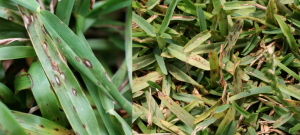Grey leaf spot, a common fungal leaf spot, is very common on St. Augustine grass during summer and early fall. High humidity, warm temperatures, and high nitrogen levels favor the development of this disease. Areas of your lawn that are partially shaded are more severely affected by the disease when frequent rains or overwatering occurs.
How will you know if this fungus has invaded your lawn? Well, symptoms on St. Augustine grass first appear as small, brown water soaked spots that will become enlarged to have a tan to gray center with purple to brown margins. These spots on the leaf blades are usually round to oblong in shape. Severely affected leaf blades usually wither and turn brown, thus giving you the impression that your grass has been scorched by drought.

Cultural practices such as limiting the levels of nitrogen and proper watering can control this disease. The lawn should be watered early in the morning or during night to reduce water loss and fungal problems. You should avoid watering in the evening prior to sunset. Be sure to water your lawn thoroughly (one inch per week to the depth of five to seven inches) to provide adequate moisture. This disease can also be controlled through the use of fungicides such as propiconazole.
Check your lawn periodically for signs of disease and insect damage. For more information about grey leaf spot or chemical rate recommendations, please call the Dougherty County Extension office at (229) 436-7216 or visit us at 125 Pine Ave Suite 100.
Information in this was obtained from Timely Tips in the Landscape and Garden, edited by Bob Websterfield; the Georgia Master Gardener Handbook, Fifth Edition; and the 2019 Georgia Pest Control Handbook, Homeowner Edition.